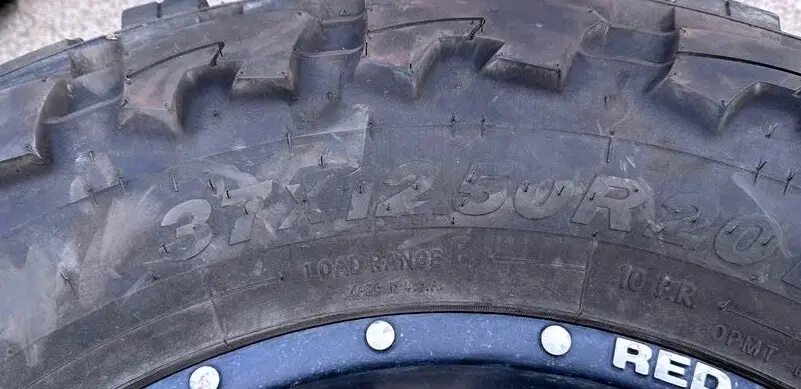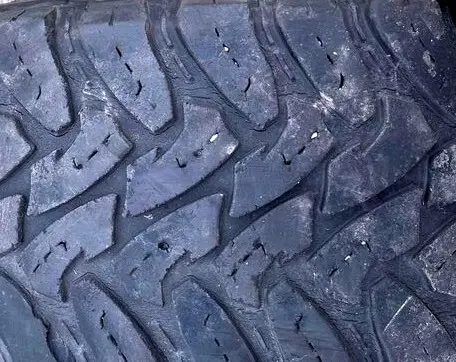Tire Size 37×12.5r20 to Metric

Have you ever been curious about those strange numbers and letters on the side of your tires? Take the 37×12.5R20 tire size, for instance. What exactly does this code signify? Let’s figure out the meaning of this enigmatic code and unlock its secrets.
Dimension Breakdown
In the tire dimension code 37×12.5R20, each part signifies a specific aspect of the tire’s dimensions. The first number, ’37,’ represents the overall diameter of the tire in inches.
Following the ‘x,’ the ‘12.5’ signifies the tire’s width, also in inches. The ‘R’ stands for Radial, indicating the tire’s construction. Lastly, the ’20’ is the wheel diameter in inches, that is, the size of the rim that the tire fits.
37×12.5r20 in inches
| Feature | Metric |
|---|---|
| Tire Diameter | 37.0″ |
| Tire Section Width | 12.5″ |
| Rim Width Range | 20″ x 8.5-11″ |
| Sidewall Height | 8.5″ |
| Circumference | 116.2″ |
| Revs/Mile | 545 |
Conversion Process
When converting this tire size to the metric system, we must focus on the Overall Diameter, Tire Width, Wheel Diameter, Sidewall Height, and Aspect Ratio.
- Overall Diameter: Since 1 inch equals 25.4 millimeters (mm), the overall diameter for a 37-inch tire will be 37 x 25.4 = 939.8 mm.
- Tire Width: Similarly, the width of a 12.5-inch tire converted into millimeters would be 12.5 x 25.4 = 317.5 mm.
- Wheel Diameter: A 20-inch wheel would translate to 20 x 25.4 = 508 mm in the metric system.
- Now, to find out the Sidewall Height and Aspect Ratio, we need to apply the following formulas:
- Sidewall Height: According to the given formula, Sidewall Height in inches = (Overall Diameter – Wheel Diameter) / 2. For our 37×12.5R20 tire, this would be (37 – 20) / 2 = 8.5 inches. Converted to millimeters, that’s 8.5 x 25.4 = 215.9 mm.
- Aspect Ratio: The Aspect Ratio is (Sidewall Height / Tire Width) * 100%. For this tire, it’s (8.5 / 12.5) * 100% = 68%.

Finding a Close Metric Equivalent
Finding a close metric equivalent to the 37×12.5R20 tire involves approximating these dimensions in a standard metric tire size format, which is expressed as [Tire Width in mm]/[Aspect Ratio]R[Wheel Diameter in mm]. Based on our previous calculations, a close metric equivalent could be a 315/70R20 tire.
Practical Applications
The 37×12.5R20 tire size is widely employed in large trucks, SUVs, and off-road vehicles due to its large overall diameter and width, providing enhanced traction and off-road capabilities.
For example, the Ford F-150 Raptor, renowned for its off-road prowess, frequently utilizes this tire size to navigate rough terrains smoothly.
Understanding and converting tire sizes can be beneficial in numerous ways. It can help you choose alternate tire sizes based on availability, costs, or specific performance needs, such as off-road traction, highway comfort, or fuel efficiency.
What Is Equivalent To A 37×12.5r20?
The tire dimension 37×12.5r20 has an approximate metric equivalent of 318/68r20, though this specific size is not typically available in the market. A more frequently encountered metric size, and the nearest comparable, would be 315/65r20, which closely matches the specifications of a 37×12.5r20 tire.
How Tall Are 37×12.5R20?
The “37” in the tire size 37×12.5R20 refers to the overall diameter of the tire, which is 37 inches tall. This is the height from the ground to the top of the tire when it’s correctly inflated.
How Wide is a 37×12.5r20 tire?
The “12.5” in the tire size 37×12.5R20 refers to the section width of the tire, which is 12.5 inches. This measurement is the distance from the widest point of a tire’s outer sidewall to the widest point of its inner sidewall when mounted and measured in inches.
What Size Rim Fits a 37×12.5r20?
The “20” in the tire size 37×12.5R20 refers to the wheel diameter of 20 inches. Therefore, this tire would fit on a 20-inch rim. Please remember that the rim width should also be appropriate for the tire width.
For a 12.5″ wide tire, a rim width of 8.5″ to 11″ is typically suitable. However, the specific tire manufacturer’s recommendations should always be followed as they may vary.
Summary
Tire sizes can initially appear perplexing, but by unraveling the components and understanding the conversion process, we can make sense of them.
This article explored the 37×12.5R20 tire size, decoding its meaning and uncovering its metric equivalents. We discussed the practical applications of this tire size, showcasing its versatility and benefits in off-road and heavy-duty scenarios.
With this knowledge, you can make informed decisions when choosing the right tire size for your vehicle, ensuring optimal performance and safety on or off the road.

Meet Caitlin McCormack, a Tire Size Expert and Blogger Passionate About Everything Related to Tires. With Years of Experience in the Tire Industry, Caitlin Has Become an Expert in Tire Sizes and Their Impact on Vehicle Performance.
